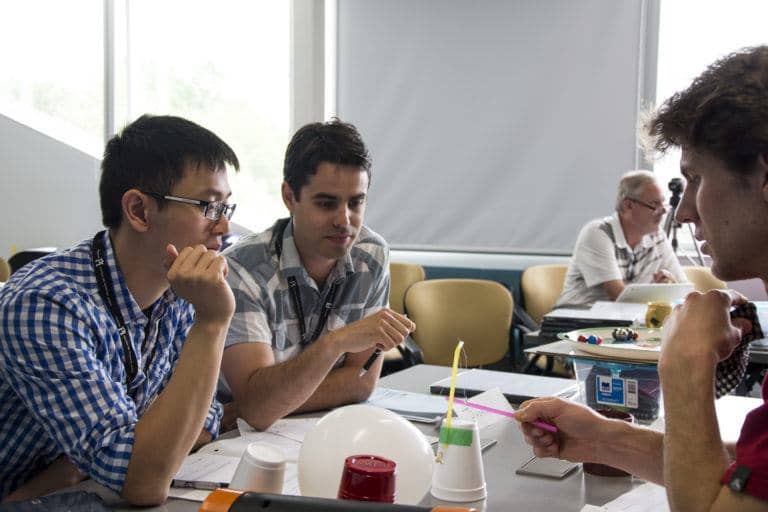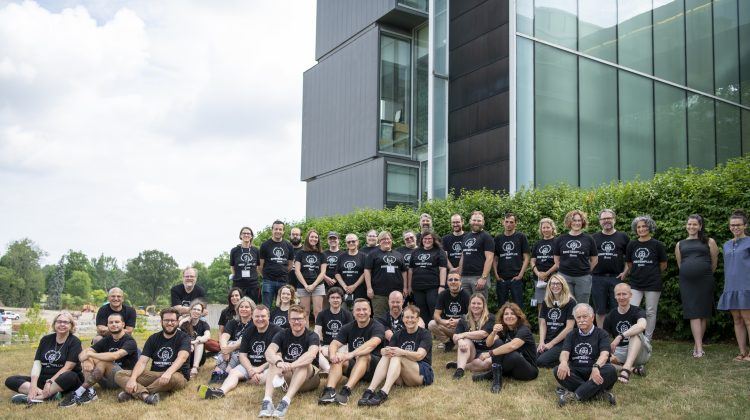Hands-on physics fun turns teachers into students
EinsteinPlus workshop brings together teachers from around the world to re-imagine physics in the classroom.

A foam dart with a suction cup is fired from a toy pistol. Someone honks a plastic bugle. A balloon bursts.
Normally, one would expect a beleaguered teacher to silence this raucous group. But this is not a normal classroom.
“This is what you get when you put a bunch of physics teachers in a room together,” says Arno Dirks, one of roughly 40 educators from around the world who, over one intense week at Perimeter Institute, have become students again.
They’ve converged for Perimeter’s EinsteinPlus workshop, which for more than a decade has immersed physics teachers in the deep end of modern physics, and supplied them with hands-on tools and techniques to share what they’ve learned with their own students.
The noisy chaos of this evening stems from last-minute preparations for Dollar Store Demos, a session in which teams of teachers deliver three-minute science demonstrations using household items.
Two days earlier, while being bused back to Perimeter after a tour of the nearby Institute for Quantum Computing, the teachers were dropped off at a local dollar store, handed envelopes containing $10 per team, and told they had 20 minutes (no more) to spend that cash (no more) on things they’d need for a fun, engaging physics demo.
The result is the hodgepodge of stuff scattered around the Perimeter classroom: a hula hoop, orange Play-Doh, marbles, plastic cups, laser pointers, toothpicks, cotton candy, and the like.
The first team launches into a demonstration in which they use a hockey stick, a metre stick, and a dustpan to show how to find the centres of mass on objects of different shapes and sizes.
Ten more teams, at three-minute intervals, dash through their presentations in this fashion, demonstrating everything from wave amplitudes (using a rope and red plastic beer cups) to gravitational lensing (a laser fired through pouring water) to gravitational potential energy (a foam dart fired at a lightweight pendulum).
The teachers have gotten to know each other well over the preceding five days of workshops and collaboration sessions, so good-natured heckling abounds. When Chris Nichols, a high school teacher from Colorado, demonstrates the relationship between acceleration and air pressure by spinning like a figure skater while holding a lit candle, someone hollers, “Nice radius!”
The teachers burst into laughter, and Nichols, dizzily, joins in. This is exactly the kind of camaraderie and collaborative atmosphere that inspired her to attend EinsteinPlus for the second time.
“I was here before and, as a result of that experience, I turned my curriculum upside-down and started infusing what I learned here,” she says later. “I found it had a dramatic impact on my students.”
That’s the driving motivation behind EinsteinPlus: to develop ways of sharing complex physics concepts – dark matter, curved spacetime, quantum theory – with students in ways that are interactive, fun, and meaningful.
Agne Junolainen, who travelled from Estonia to attend EinsteinPlus, describes it as an “amazing” experience that (almost) made her wish summer vacation were already over: “I can’t wait to get back and rewrite my courses to incorporate these things into my classroom.”
The frenetic silliness of the Dollar Store Demos aside, the workshop tackles serious questions about learning and pedagogy, and gives teachers the tools and support they need to reach students who otherwise might have an aversion to science.
For Miles Hudson, a teacher from Durham in northern England, the most rewarding aspect of EinsteinPlus is knowing that it will benefit students at a pivotal point in their lives, when a spark of revelation about science might influence their future careers.
“Until you’ve actually been on the EinsteinPlus week, you cannot comprehend just how incredibly useful it will be directly in your classroom,” says Hudson. “And I always tell my students that with physics you can explain anything. It’s so powerful.”
– Colin Hunter
FURTHER EXPLORATION























































































